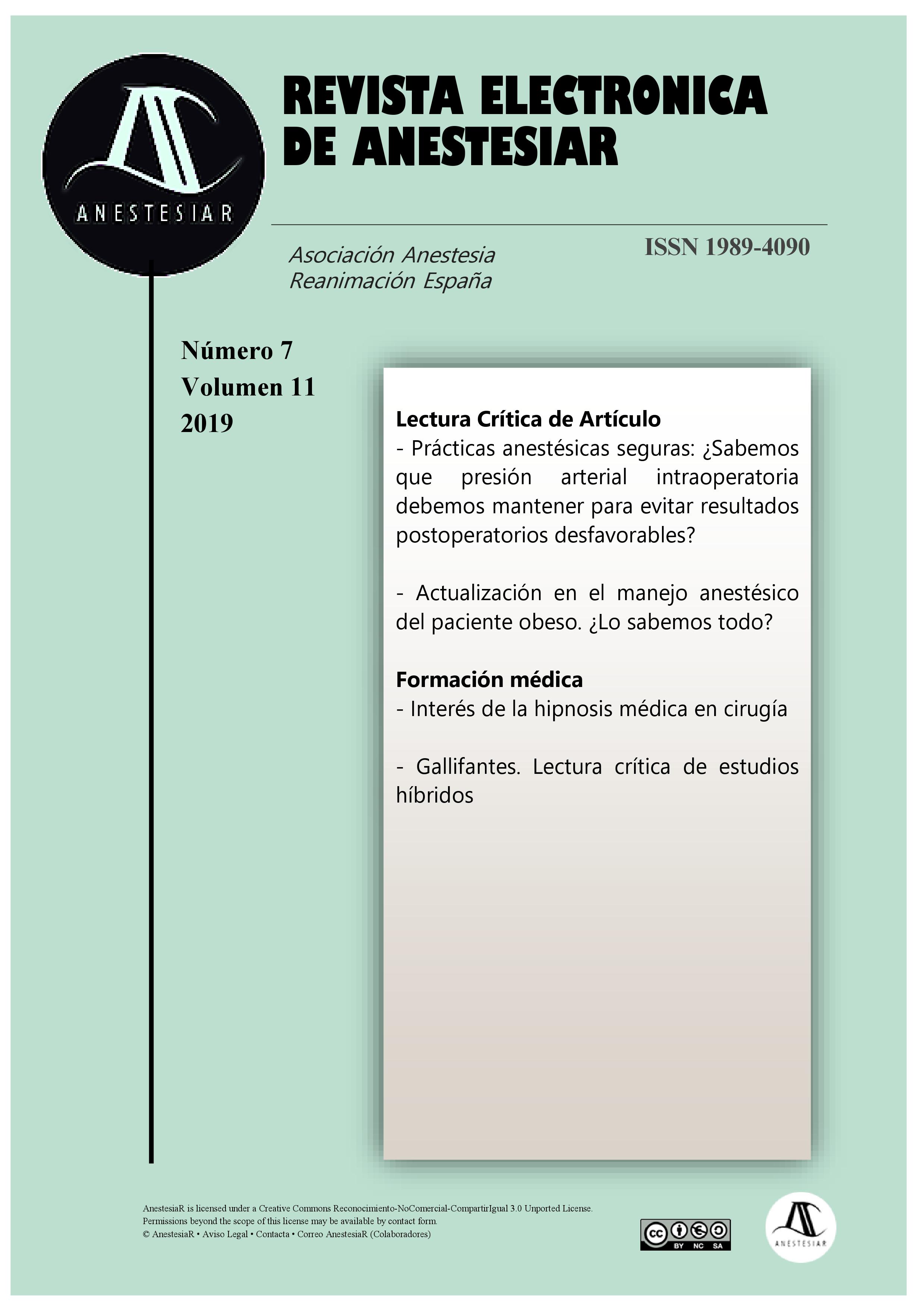Actualización en el manejo anestésico del paciente obeso. ¿Lo sabemos todo?
DOI:
https://doi.org/10.30445/rear.v11i7.766Palabras clave:
obesidad, manejo periperatorio, anestesiaResumen
La obesidad creciente en nuestro medio es un factor de riesgo para la aparición de complicaciones perioperatorias. Un manejo perioperatorio individualizado, teniendo en cuenta la idiosincrasia de estos pacientes es esencial para mejorar los resultados y la seguridad del procedimiento quirúrgico. Un manejo anestesico adecuado puede cambiar sustancialmente el desenlace vital de estos pacientes.
Citas
- OMS, informe 16 febrero de 2018. http://apps.who.int/mediacentre/factsheets/fs311/es/index.html
- Estrategia NAOS Ministerio de Sanidad y Consumo. www.aecosan.msssi.gob.es/AECOSAN/docs/documentos/nutricion/estrategianaos.pdf
- Nightingale CE, Margarson MP, Shearer E, Redman JW, Lucas DN et al. Guidelines: Perioperative management of the obese surgical patient 2015. Anaesth 2015; 70, 859-76.
- Adams JP, Murphy PG. Obesity in anaesthesia and intensive care, endocrine and metabolic disorders in anaesthesia and intensive care. Br J Anaesth 2000; 85:91-108.
- Fyneface-Ogan S, Aqbam DS, Numbere C. Anaesthesic management of a super morbidly obese patiente for total abdominal hysterectomy: a few lessons to learn. African Health Sciences 2012; 12: 181-5.
- O'Gara B, Talmor D. Perioperative lung protective ventilation BMJ 2018; 10: 362:k3030. doi: 10.1136/bmj.k3030.
- Gaszynski T., Gaszynska E., Szewwczyk T. Dexmedetomidine for awake intubation and a opioid-free general anesthesia in a superobese patient with suspected difficult intubation. Drug Design, Development and Therapy 2014; 8: 909-12.
- Liew NC., Alemany GV., Angchaisuksiri P. Asian venous thromboembolism guidelines: updated recommendations for the prevention of venous thromboembolism. Int Angiol 2017; 36: 1-20.
- Walsh MT. Improving outcomes in ambulatory anesthesia by identifying high risk patients. Anestesiol 2018; 31: 659-66.
- Haskins SC, Kruisselbrink R, Boublik J, Wu CL, Perlas A. Gastric Ultrasound for the Regional Anesthesiologist and Pain Specialist. Reg Anesth Pain Med 2018; 43: 689-98.
- Estrategia NAOS Ministerio de Sanidad y Consumo. www.aecosan.msssi.gob.es/AECOSAN/docs/documentos/nutricion/estrategianaos.pdf
- Nightingale CE, Margarson MP, Shearer E, Redman JW, Lucas DN et al. Guidelines: Perioperative management of the obese surgical patient 2015. Anaesth 2015; 70, 859-76.
- Adams JP, Murphy PG. Obesity in anaesthesia and intensive care, endocrine and metabolic disorders in anaesthesia and intensive care. Br J Anaesth 2000; 85:91-108.
- Fyneface-Ogan S, Aqbam DS, Numbere C. Anaesthesic management of a super morbidly obese patiente for total abdominal hysterectomy: a few lessons to learn. African Health Sciences 2012; 12: 181-5.
- O'Gara B, Talmor D. Perioperative lung protective ventilation BMJ 2018; 10: 362:k3030. doi: 10.1136/bmj.k3030.
- Gaszynski T., Gaszynska E., Szewwczyk T. Dexmedetomidine for awake intubation and a opioid-free general anesthesia in a superobese patient with suspected difficult intubation. Drug Design, Development and Therapy 2014; 8: 909-12.
- Liew NC., Alemany GV., Angchaisuksiri P. Asian venous thromboembolism guidelines: updated recommendations for the prevention of venous thromboembolism. Int Angiol 2017; 36: 1-20.
- Walsh MT. Improving outcomes in ambulatory anesthesia by identifying high risk patients. Anestesiol 2018; 31: 659-66.
- Haskins SC, Kruisselbrink R, Boublik J, Wu CL, Perlas A. Gastric Ultrasound for the Regional Anesthesiologist and Pain Specialist. Reg Anesth Pain Med 2018; 43: 689-98.
Descargas
Publicado
2020-08-13
Cómo citar
Sánchez Quirós, B., & Herrero, M. A. P. (2020). Actualización en el manejo anestésico del paciente obeso. ¿Lo sabemos todo?. Revista Electrónica AnestesiaR, 11(7), 2. https://doi.org/10.30445/rear.v11i7.766
Número
Sección
Comentarios de artículos
Licencia
Derechos de autor 2019 Revista Electrónica AnestesiaR

Esta obra está bajo una licencia internacional Creative Commons Atribución-CompartirIgual 4.0.
 Envío y derechos de autor
Envío y derechos de autor


 Revista Electrónica AnestesiaR by
Revista Electrónica AnestesiaR by 